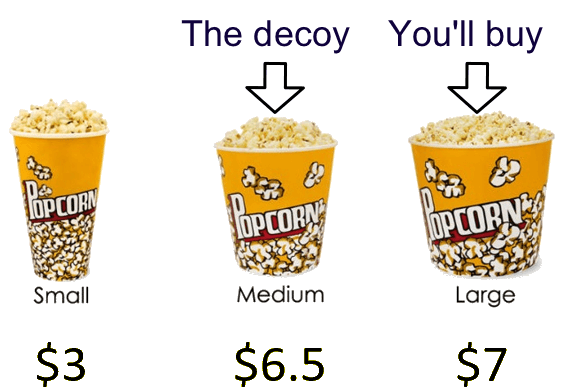The Decoy Effect: Pricing Using Alternatives
🔥 While lining up at a movie theatre to buy some popcorn you are feeling very hungry. So you intend to buy a medium-sized bag of popcorn. But when you get to the counter, you see a small one costs $4; the medium is $7.50; and the large is $8. You don't really need a whole large popcorn, but you end up buying it anyway, because it's a much better deal than the medium. This is what is known with the Decoy Effect. it is an interesting cognitive illusion in the way we make decisions and stands as an example of irrational decision making.

The decoy effect is the phenomenon whereby consumers will tend to have a specific change in preference between two options when also presented with a third option that is asymmetrically dominated. In simple terms, when deciding between two options, an unattractive third (middle) option can change the perceived preference between the other two, typically in favor of the more expensive one.
By introducing a third unpopular option, the decoy effect can cause us to spend and consume more than we really need. When a decoy option is present, we tend to make decisions based less on which option actually best suits our needs, but instead based more on what feels like the most advantageous choice.
We think we are fully in the driver seat and that we are not under any external factors when making our choices about what we will wear, eat or donate. Yet this Decoy Effect is a clear proof that we can be influenced by marketers, politicians, etc. while we believe we are making a sane, fully conscious decisions.
Decoys are a commonly used tool by businesses and corporations, to "nudge" us into buying more than we really need. Introducing a 3rd option makes it more alluring to us to buy into the most expensive, most feature-rich product or service; even if we not really need it.
Dan Ariely, a known behavioral economist was once provoked when he saw a puzzling set of options on the Economist Newspaper website which at the time offered its prospective subscribers: "You could get access to all our web content for $59, a subscription to the print edition for $125, or a combined print and web subscription, also for $125".
Later he stated about this ad that by introducing a middle, third option in the above example this caused the readers to choose the combined print and web option that increased the newspaper profit by 43%.
The general idea is that we don't know our preferences that well, and because of that we are susceptible to influences of external forces. Unfortunately, following our intuition doesn't always mean we're making the smartest choice. Most of the time, the decoy effect leads us to pick a more costly alternative than we would have chosen otherwise.
⇨ Please share any additional info or experiences with respect to the decoy effect. Thank you.



